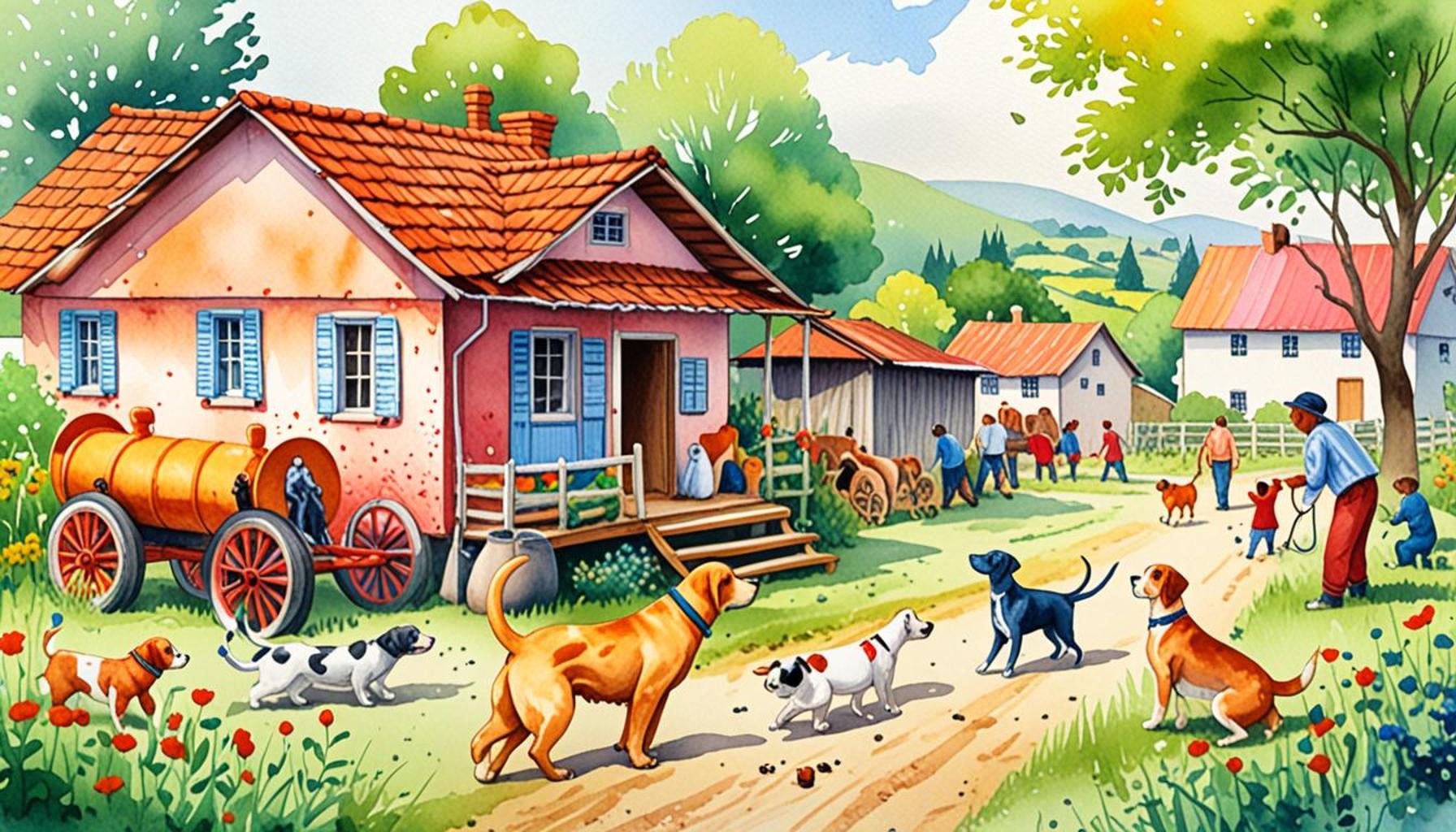How to Adapt Traditional Training Methods for Pets in Rural Communities

Understanding the Context of Pet Training in Rural Nigeria
The dynamics of pet ownership in rural Nigeria bring a unique set of circumstances that influence how pets are trained. In lush valleys and sprawling open fields, the environment offers both advantages and obstacles. Unlike urban areas where pet training is often structured and supervised by professionals, rural settings necessitate creativity and resourcefulness among pet owners.
Many pet owners encounter significant barriers, such as:
- Limited access to professional trainers: In many rural communities, qualified trainers may be few and far between. This lack of professional services can lead to inconsistent training outcomes, leaving pet owners to rely heavily on their instincts and traditional knowledge.
- Varied training environments: Rural settings often consist of vast open spaces where pets can roam freely, contrasting starkly with confined spaces like urban apartments. These varied environments can impact the effectiveness of traditional training techniques, requiring adaptations to suit the surroundings.
- Different breeds: In rural Nigeria, pet ownership often includes a mix of indigenous breeds and imported ones. Each breed presents unique behavioral traits; for instance, local breeds may be more adaptable to outdoor training, while bred pets could require more structured activities.
Adapting Traditional Methods of Pet Training
To overcome these challenges, pet owners can adapt traditional training methods to better suit their specific situations. Implementing customized training techniques can enhance not only the pets’ behavior but also strengthen the bond between owner and pet.
Here are some effective strategies that can be utilized:
- Utilizing local resources: Community gatherings, events, or informal pet clubs can serve as great venues for socializing pets while learning effective training practices from fellow pet owners. Such communal activities also foster a sense of fellowship and shared experiences among pet lovers.
- Incorporating practical training routines: Training sessions can be integrated into daily chores. For example, while fetching water from a nearby well, a dog can be trained to follow simple commands. This method emphasizes the importance of consistency in everyday activities.
- Encouraging socialization: Exposure to other animals is crucial in rural environments. Allowing pets to interact with livestock or other local animals can build their confidence and teach them essential social skills necessary for balanced behavior.
Conclusion
The rural landscape of Nigeria necessitates a thoughtful approach to pet training, taking into account the unique lifestyle and environmental aspects of these communities. By tailoring traditional training techniques to fit their environment, pet owners can cultivate a nurturing atmosphere that promotes the well-being of their pets.

Moving forward, awareness and exploration of these customized methods will not only lead to successful training outcomes but will also enhance pet owners’ experience, ensuring that they enjoy the companionship of their pets in a harmonious manner. As communities evolve and adapt, so too can our approaches to pet care, paving the way for brighter futures for both pets and their owners.
RECOMMENDED: Check out this similar article
Creative Strategies for Training Pets in Rural Settings
Adapting traditional training methods for pets in rural communities requires innovative thinking and an understanding of the local lifestyle. Unlike their urban counterparts, pet owners in rural areas often find themselves integrating training into their daily routines, which can yield remarkable results. Here are some creative strategies that can elevate pet training while considering the unique circumstances present in these communities:
- Leveraging Local Knowledge: Many rural communities are rich in traditional wisdom and animal husbandry practices. Pet owners can benefit from this local knowledge by engaging elder community members or farmers who have experience with animal behavior. These individuals can provide valuable insights on effective training methods that are based on years of observation and practice.
- Creating a Structured Environment: While the expanse of rural land offers great freedom, it can also lead to distractions that may hinder training. Establishing a designated training area, whether it’s a corner of the yard or a quiet spot near the home, can help minimize distractions. This approach allows pet owners to focus their pets’ attention on the training without interference from wildlife or other elements.
- Positive Reinforcement through Local Treats: Utilizing local food items as training rewards can significantly improve the effectiveness of training sessions. For instance, small pieces of dried fish or locally prepared snacks can serve as powerful motivators for pets. By associating commands with these rewards, pets are more likely to learn and respond positively, creating a stronger bond with their owners.
Building Consistency with Daily Activities
Incorporating pet training into routine tasks not only maximizes the use of time but also enforces discipline in both pet and owner. Here are some adaptable methods:
- Training During Farm Visits: Engaging pets during farm tasks such as herding livestock or controlling pests can be beneficial. Owners can teach their pets commands like “stay” or “come” while actively involved in these chores, thereby reinforcing training through practical application.
- Exercise as a Part of Training: Rural life often includes ample opportunities for physical activity, which can be incorporated into training routines. Taking dogs on long walks or allowing them to run in open spaces can serve dual purposes: providing exercise while reinforcing commands such as “heel” or “fetch.”
- Involving Family and Friends: Involving other members of the household or friends in training sessions enhances socialization for pets and allows them to learn to respond to commands from different people. This practice is beneficial, especially when regular interaction with various family members is common in rural settings.
Through these tailored strategies, training can evolve from a chore to an enjoyable experience for both pets and their owners. Moreover, as rural communities continue to adapt and thrive, sharing success stories about effective training will foster awareness and encourage positive pet ownership practices among neighbors.
Adapting traditional training methods for pets in rural communities can significantly enhance both pet behavior and the bond between animals and their owners. Understanding the unique challenges faced in these areas is crucial to developing effective training strategies. Here are some pivotal aspects to consider:
| Training Technique | Advantages |
|---|---|
| Positive Reinforcement | Encourages desirable behavior by rewarding pets with treats or praise, fostering a happy learning environment. |
| Socialization through Community Interaction | Allows pets to experience various human interactions and settings, promoting confidence and reducing anxiety. |
Utilizing local community resources such as schools and parks to conduct training sessions can enhance the social dynamics of both pets and owners. Further, adapting methods to include local wildlife encounters can help pets learn to react appropriately to their surroundings. Emphasizing play and engagement in rural settings capitalizes on available space and strengthens the learning process, making it enjoyable for both pets and owners.
Moreover, incorporating local culture into training methods can yield positive results. Training sessions can be combined with traditional community events, allowing for greater participation and appreciation of the methods being employed. As a result, not only are pets better trained, but communities grow closer, united by their shared experiences and love for animals.
CHECK OUT: Click here to explore more
Engaging the Community for Effective Training Methods
In rural communities, training pets can be more effective when achieved through collective engagement and support. Community involvement not only enhances the training experience but fosters a sense of unity among pet owners, leading to shared knowledge and practices. Here are some ways to tap into community resources and collaborative learning:
- Establishing Training Workshops: Organizing workshops within the community can serve as a platform for sharing experiences and techniques among pet owners. These gatherings can feature demonstrations of successful training methods, discussions on common challenges, and even guest speakers from local veterinary clinics or animal behaviorists. Such initiatives can galvanize community engagement and promote a culture of responsible pet ownership.
- Local Training Groups: Forming local training groups creates an environment where pet owners can learn from each other. Regular meet-ups can serve as training sessions, facilitating socializing opportunities for both pets and their owners. For instance, in Nigeria, community groups can leverage traditional storytelling sessions where owners share successful training anecdotes, which not only provide practical tips but strengthen community ties.
- Participating in Local Events: Rural festivals and markets often feature competitions or showcases. By participating in these events, pet owners can provide live demonstrations of their training techniques. This not only promotes awareness but also encourages onlookers to adopt similar strategies for their own pets, ultimately fostering a community culture centered around proper pet training.
Embracing Technology for Training Enhancement
While traditional methods are valuable, integrating technology can further augment training efforts in rural areas. The accessibility of mobile technology in Nigeria and various regions offers extraordinary opportunities to connect and learn:
- Utilizing Mobile Apps: There are numerous mobile applications designed specifically for pet training. These platforms often provide structured plans and instructional videos that pet owners can follow. Easy access to such resources can empower rural pet owners to refine their training methods systematically. For example, apps can help track progress and set timely reminders for training sessions, ensuring consistency and accountability.
- Online Communities and Forums: Engaging in online pet training forums and social media groups can broaden horizons. Users can share stories, ask for advice, and troubleshoot common problems. This digital engagement can be especially beneficial in rural areas where traditional veterinary or trainer support may not be readily available, creating a bridge between localized knowledge and global insights.
- Educational Content via Social Media: Leveraging platforms popular in Nigeria, such as WhatsApp or Facebook, to share videos or words of encouragement can motivate both pets and owners to adhere to training schedules. Creative video content demonstrating training methods, success stories, and tips can resonate well with the community and provide a visual learning tool.
By combining community engagement with technological resources, training pets in rural settings can evolve into a more structured and rewarding process. This not only enhances the pet-owner relationship but also cements the importance of responsible pet ownership within the community culture, leading to more harmonious living conditions for both humans and their beloved animal companions.
SEE ALSO: Click here to read another article
Conclusion: Transforming Pet Training in Rural Communities
Adapting traditional training methods for pets in rural communities requires a thoughtful synthesis of local culture, community involvement, and modern technology. The essence of fostering responsible pet ownership extends beyond individual pet owners; it thrives on the collective strength of the community. By organizing workshops, forming local training groups, and participating in community events, pet owners can share resources, knowledge, and experiences that enrich the training landscape.
Moreover, the integration of technology offers unprecedented opportunities for these communities. From utilizing mobile training apps to engaging in online forums, accessible resources empower pet owners to refine their training methods effectively. The utilization of platforms like WhatsApp and Facebook further enhances communication and learning, making quality training techniques available even in the most remote areas.
Ultimately, the journey to training pets successfully in rural settings is about more than just obedience; it is about nurturing strong bonds between pets and their owners, cultivating a sense of community, and fostering a respect for animal well-being. As these communities engage in shared learning experiences and embrace both traditional and modern methods, they pave the way for a brighter future in responsible pet ownership. This approach not only elevates the quality of life for pets but enriches the community fabric, making it essential for stakeholders to adopt these methods. The road ahead is ripe with potential—let’s seize this opportunity to transform our approach to pet training.


